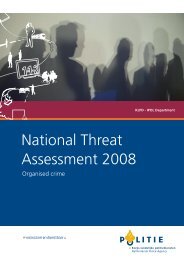Assessing the Effectiveness of Organized Crime Control Strategies ...
Assessing the Effectiveness of Organized Crime Control Strategies ...
Assessing the Effectiveness of Organized Crime Control Strategies ...
Create successful ePaper yourself
Turn your PDF publications into a flip-book with our unique Google optimized e-Paper software.
<strong>Assessing</strong> <strong>the</strong> <strong>Effectiveness</strong> <strong>of</strong> <strong>Organized</strong> <strong>Crime</strong> <strong>Control</strong> <strong>Strategies</strong>:<br />
A Review <strong>of</strong> <strong>the</strong> Literature<br />
organized crime family.” In addition, its requirement <strong>of</strong> proving a “pattern <strong>of</strong> racketeering<br />
activity” and its broad definition <strong>of</strong> “racketeering activity” allowed <strong>the</strong> prosecution in <strong>the</strong><br />
Columbo case to include in a single indictment <strong>the</strong> various state and federal <strong>of</strong>fences committed<br />
by that Family over a period <strong>of</strong> 15 years.<br />
The same broad definition <strong>of</strong> racketeering that has served as a virtue <strong>of</strong> RICO has also been<br />
subject to considerable criticism (Greek, 1991). RICO has been used to prosecute many<br />
individuals without OC connections and brings with it <strong>the</strong> stigma <strong>of</strong> being labeled a “racketeer”<br />
(Abadinsky, 2003:320). In Chicago, for example, a deputy sheriff and traffic court clerk were<br />
convicted under RICO for fixing parking tickets. RICO has also been used frequently to deal<br />
with crimes by legitimate corporations. In fact, any enterprise committing two or more felonies<br />
within a 10-year period is subject to prosecution under RICO (Albanese, 1996:197). RICO has<br />
been judged a “dramatic failure” in attacking OC’s infiltration <strong>of</strong> legitimate businesses, as fewer<br />
than eight percent <strong>of</strong> <strong>the</strong> cases fall within this category (Lynch, 1987). Ironically, many RICO<br />
cases have involved government agencies that have been corrupted (Greek, 1991).<br />
Aside from RICO, federal prosecutors in <strong>the</strong> US can avail <strong>the</strong>mselves <strong>of</strong> ano<strong>the</strong>r statute to target<br />
OC figures. The Continuing Criminal Enterprise (CCE) law, enacted in 1987, is limited to drug<br />
traffickers and makes it a crime to engage in a conspiracy to commit at least three related<br />
violations <strong>of</strong> felony drug laws with five or more individuals (Albanese, 1996:199). It provides<br />
for mandatory minimum sentences <strong>of</strong> 20 years for first violations, fines up to $2 million, and<br />
forfeiture <strong>of</strong> pr<strong>of</strong>its and any interest in <strong>the</strong> enterprise.<br />
Data for 1990 indicates that, for both RICO and CCE cases, just about a third <strong>of</strong> suspects<br />
investigated are eventually charged (Albanese, 1996:200). This is due to <strong>the</strong> complexity and<br />
length <strong>of</strong> <strong>the</strong>se cases, although some <strong>of</strong> those not charged under RICO or CCE are eventually<br />
charged with o<strong>the</strong>r crimes. Once charged, more than 80% <strong>of</strong> <strong>the</strong> defendants prosecuted under<br />
<strong>the</strong>se laws are convicted.<br />
Approximately one-half <strong>of</strong> US states have passed <strong>the</strong>ir own RICO laws, although <strong>the</strong>y have not<br />
been used very frequently thus far (Albanese, 1996:199). A survey <strong>of</strong> local prosecutors found<br />
that less than a third reported a prosecution against OC between 1989 and 1991 (Rebovich,<br />
Coyle, and Schaaf, 1993:8).<br />
In Canada, Sections 467.11 to 467.13 <strong>of</strong> <strong>the</strong> Criminal Code prohibits participation in and<br />
contribution to criminal organizations or <strong>the</strong> commission <strong>of</strong> indictable <strong>of</strong>fences for <strong>the</strong> benefit <strong>of</strong><br />
such an organization. This review did not uncover any studies assessing <strong>the</strong> implementation or<br />
impact <strong>of</strong> <strong>the</strong>se provisions on criminal organizations or <strong>the</strong>ir activities.<br />
4.2 Prosecuting <strong>Organized</strong> <strong>Crime</strong> Kingpins<br />
For decades, law enforcement strategies have focused on identifying and prosecuting <strong>the</strong> leaders<br />
<strong>of</strong> criminal enterprises (Lyman and Potter, 1997:433). Members may be charged or arrested for<br />
relatively minor infractions. Charges for even small infractions provides prosecutors with <strong>the</strong><br />
leverage to conduct fur<strong>the</strong>r investigations <strong>of</strong> <strong>the</strong> group. The goal is to get “smaller fish” to “flip”<br />
and testify against <strong>the</strong> heads <strong>of</strong> <strong>the</strong> organization. The ultimate aim is to disrupt <strong>the</strong> group. This<br />
20 | Research and Statistics Division / Department <strong>of</strong> Justice Canada








